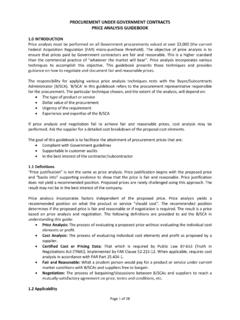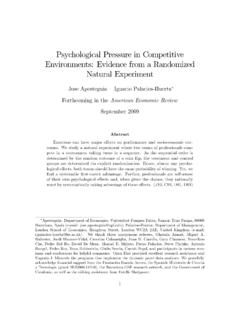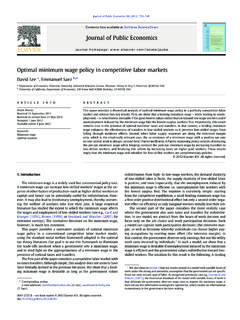Transcription of ICN Unilateral Conduct Working Group …
1 ICN Unilateral Conduct Working Group dominance / substantial MARKET POWER analysis PURSUANT TO Unilateral Conduct LAWS Recommended Practices The concept of dominance or substantial market power limits the scope of application of most Unilateral Conduct laws. Making dominance or substantial market power a prerequisite for intervention under Unilateral Conduct laws serves as a filter for intervention against specific anti-competitive The concept of dominance pursuant to Unilateral Conduct laws is generally equivalent to the possession of substantial market power, and thus this document uses the terms dominance and substantial market power interchangeably. Market power is defined generally as the ability to price profitably2 above the competitive level. dominance / substantial market power is a high degree of market power both with respect to the level to which price can be profitably raised and to the duration that price can be maintained at such a level.
2 The degree of market power required to constitute dominance / substantial market power and the nature and extent of the evidence required to establish dominance / substantial market power are basic and important policy choices made by legislatures, competition agencies, and courts. The work of the Unilateral Conduct Working Group in 2006-2007 highlights different policy choices as to what is required to constitute and establish dominance / substantial market power. All jurisdictions agree that Unilateral Conduct laws address specific Conduct and its anticompetitive effects, rather than the mere possession of dominance / substantial market power or its creation through competition on the merits. All jurisdictions also agree that the goal of enforcement is to identify and act against Conduct that is anticompetitive, although it can be difficult to distinguish between pro- and anti-competitive Unilateral Conduct .
3 Determining whether a firm possesses dominance / substantial market power generally is the first step in the evaluation of potentially anti-competitive Unilateral Conduct . Laws differ in the way dominance / substantial market power is defined. Most jurisdictions find that a rigorous assessment of whether a firm possesses dominance / substantial market power, going well beyond market shares, is highly desirable. In jurisdictions with a more formalistic definition of dominance based on market shares, it is recommended that agencies be particularly rigorous in their analysis of the Conduct at issue. 1 See ICN Report on the Objectives of Unilateral Conduct Laws, Assessment of dominance / substantial Market Power, and State-Created Monopolies.
4 2 The ability to raise and maintain prices is used as a shorthand for the various ways in which market power can be exercised. 2 Based on the Group s work during 2006-2007, the ICN recommends the following practices for the assessment of dominance / substantial market power in the context of Unilateral Conduct laws: I. General Framework 1. Agencies should use a sound analytical framework firmly grounded in economic principles in determining whether dominance / substantial market power exists. Comment: Properly assessing whether a firm possesses dominance / substantial market power, is a complex and multi-faceted analysis . Although each jurisdiction has chosen its own specific wording for the legal definition of dominance / substantial market power, there is increasing convergence toward the principle that the analysis reaches well beyond market shares.
5 The analysis of dominance / substantial market power, therefore, should be based on the assessment criteria mentioned in section II. 2. A firm should not be found to possess dominance / substantial market power without a comprehensive consideration of factors affecting competitive conditions in the market under investigation. Comment 1: Various market characteristics determine the extent to which a firm is or is not constrained by competitive pressure, in particular from actual or potential competitors. Agencies should assess dominance / substantial market power by directly investigating how the particular relevant market operates and the competitive situation in the market. Comment 2: The analysis of dominance / substantial market power includes but does not stop with the assessment of market shares. At a minimum, conditions of entry and expansion (affecting the durability of market power) should also be assessed.
6 Agencies should, where appropriate, also take into account other criteria such as buyer power, economies of scale and scope/network effects, and access to upstream markets/vertical integration. II. Assessment Criteria 3 Market shares 3. Market shares of the firm under investigation and its existing competitors, including their development during the past years, should be used as an indication or starting point for the dominance / substantial market power analysis . Comment 1: Market shares are generally used as the starting point for assessing market power. Market shares provide useful information about the firm s past market success. In most markets, a firm s market share is an important factor that provides a first indication as to whether a firm has market power and, if so, the degree of its market power.
7 Comment 2: Market shares provide a useful first indication of the market structure and of the competitive importance of various firms active on the market (the relative market position of the firm under investigation compared to its competitors). However, since market shares fail to reflect certain important features of the competitive environment, in particular market dynamics, they should be put into perspective by consideration of other factors, such as potential entry, when assessing the degree of market power of the firm under investigation. Comment 3: Additional weight should be given to the assessment of whether market shares have been or could be maintained over a significant period of time. Such maintenance can be an indication of durable market power, while historic volatility could indicate its absence.
8 4. Agencies should give careful consideration to the calculation of market shares. Comment 1: Market shares are useful in the analysis of market power only when they are based on properly defined product and geographic markets. Market share calculations should be based on reliable data and sources, and sound assumptions. Comment 2: Market shares should be based on a measure that is appropriate to the characteristics of the market and they should be interpreted in the light of the relevant market conditions. Changes in market conditions should be considered in interpreting market shares. Comment 3: In practice, market shares, in particular for heterogeneous products, are most often defined in value terms, expressed by turnover. However, other methods of calculation, such as quantities, production capacities and volume of orders, can be useful.
9 4 Market Share Safe Harbors/Indicators 5. It can be beneficial to use market share-based thresholds as a safe harbor. Comment 1: Agencies can use market shares to establish a level under which an agency generally will not find dominance / substantial market power (a safe harbor ). Possession of a market share outside the safe harbor is generally necessary but insufficient for finding dominance / substantial market power. Whether a firm with a market share outside the safe harbor possesses dominance / substantial market power or not, requires a detailed analysis including additional factors. Comment 2: Jurisdictions use different types of safe harbors, based on different market share levels. Some agencies use safe harbors that guarantee that dominance / substantial market power will not be found below the safe harbor level, which maximizes certainty and reduces agency burdens, while others establish only a rebuttable presumption against a finding of dominance / substantial market power.
10 The benefits of safe harbors have to be weighed against their risks, in particular potential over-emphasis on market shares and thus potential enforcement errors. 6. It can be beneficial to use market share-based thresholds as an indicator of dominance / substantial market power. Comment 1: In some jurisdictions, demonstration of a sufficiently high market share creates a presumption of dominance / substantial market power. In jurisdictions in which the presumption shifts the burden of proof to the firm under investigation to provide evidence of why it is not dominant, the agency should remain receptive toward evidence that may overcome the presumption ( , that the market operates competitively). In other jurisdictions, although high market shares serve as an initial indicator of potential dominance / substantial market power, the burden of carrying out a thorough market investigation establishing dominance / substantial market power remains with the agency.

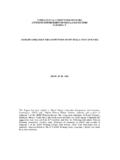


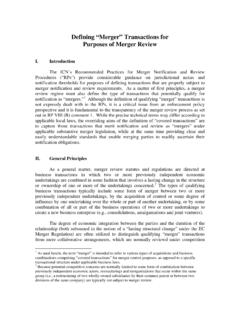


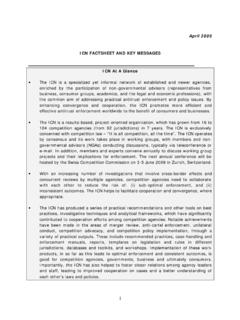
![[MERGER NOTIFICATION PROCEDURE TEMPLATE]](/cache/preview/4/4/e/2/5/9/d/c/thumb-44e259dc3896a9580aeac27f113f9044.jpg)


